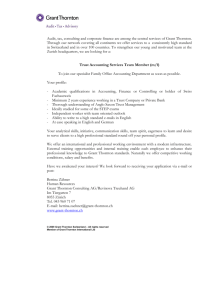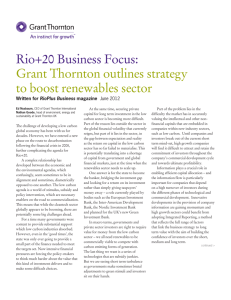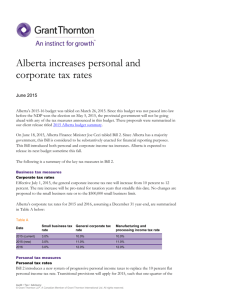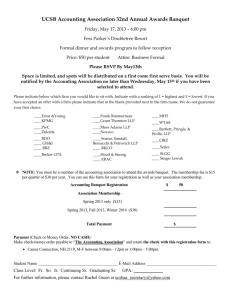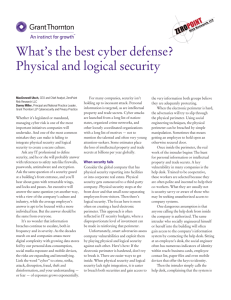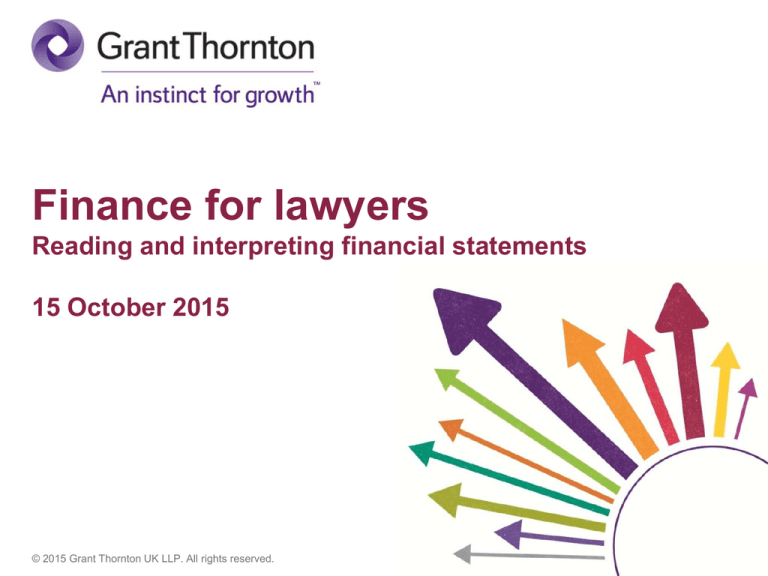
Finance for lawyers
Reading and interpreting financial statements
15 October 2015
© 2015 Grant Thornton UK LLP. All rights reserved.
Reading and interpreting financial statements
Speakers
• Andrew Brown
Director, Forensic and Investigation Services
• Matthew Stroh
Associate Director, Head of Audit Technical
• Alison Ewing
Associate Director, Forensic and Investigation Services
© 2015 Grant Thornton UK LLP. All rights reserved.
Reading and interpreting financial statements
Topics for today
•
•
•
•
•
basic financial statements/accounts
understanding statutory financial statements
using accounts to value a business
"creative" accounting
interpreting accounts – what you can find from a set of accounts if you
know where to look
© 2015 Grant Thornton UK LLP. All rights reserved.
Basic financial statements/
accounts
© 2015 Grant Thornton UK LLP. All rights reserved.
Basic financial statements
•
•
•
•
•
•
who uses accounts?
accounts of different entities
internal v external users
when an audit is needed and what it involves
what is meant by an 'accountant's report'
key statements within a set of accounts
– profit and loss account (or income statement)
– balance sheet (or statement of financial position)
– cash flow statement
© 2015 Grant Thornton UK LLP. All rights reserved.
Who uses accounts?
Owners
Customers
Managers
Competitors
Employees
Business
Lenders
Suppliers
© 2015 Grant Thornton UK LLP. All rights reserved.
Government
Investment
analysts
Community
representatives
Reasons for attending today
What are your reasons for looking at accounts
and attending today?
• understanding your own organisation's financial
performance?
• vetting customers/suppliers?
• assessing acquisition targets?
• assessing businesses litigating or making claims?
• other?
• need the 4 CPD points?
© 2015 Grant Thornton UK LLP. All rights reserved.
Accounts of different entities
Sole trader or
partnership
Limited company or
Limited Liability
Partnership
Public company
No statutory
requirement for
accounts,
prepared for tax
purposes only
Financial accounts to be
prepared and filed within 9
months of the period end.
Companies Act sets out
prescribed format and
content (some exemptions
for small/medium-sized
companies)
Financial accounts to be
prepared and filed within 6
months of the period end.
Significant additional
requirements and
increased disclosure
Audit not required
Audit required (unless small)
Audit required
© 2015 Grant Thornton UK LLP. All rights reserved.
Internal v external users
Financial accounts
•
•
•
•
produced for external users
standard format
subject to accounting
regulations
accounts may be out of date
(published accounts may be
filed 9 months after the year
end – 6 months for public
company)
© 2015 Grant Thornton UK LLP. All rights reserved.
Management accounts
•
•
•
•
•
•
produced by management for
management
format varies depending on
requirements of the business
usually produced monthly
banks may require copies
not always prepared by small
companies
may be less accurate than
published accounts
What does an audit involve?
ICAEW guidelines – an auditor should:
• carry out procedures to obtain sufficient appropriate audit
evidence...to determine with reasonable confidence whether
the financial statements are free from material misstatement
Materiality – the accounts are free from material misstatement. A
material item is one that would influence the decisions of the user)
– for example, an item of 'x'% of profit
• ensure overall presentation of the financial statements are in
accordance with relevant legislation and accounting
standards
© 2015 Grant Thornton UK LLP. All rights reserved.
Audit opinion
If unqualified, the opinion will state that financial statements:
• show a true and fair view
• have been prepared in accordance with applicable accounting
standards
• have been prepared in accordance with Companies Act 2006
Various 'modified' options:
•
•
•
•
qualified (eg limitation of scope, or 'except for')
adverse
disclaimer
emphasis of matter
© 2015 Grant Thornton UK LLP. All rights reserved.
Accountant's report
If published accounts are not audited, they are often
accompanied by an 'accountant's report', for
example:
“We have prepared without audit, the above balance
sheet and annexed trading and profit and loss
account from the books, vouchers, information and
explanations given to us, and certify them to be in
accordance therewith.”
© 2015 Grant Thornton UK LLP. All rights reserved.
Key statements within a set of accounts
Profit and loss
account
Summary of the
trading transactions
for a period
Financial history of
the business
© 2015 Grant Thornton UK LLP. All rights reserved.
Balance sheet
Cash flow
statement
Financial position at
the period end
Analysis of the
movement in cash
over a period
Snap shot of the
assets and
liabilities
Cash generating
ability of the
business
Key statements within a set of accounts
Profit and loss account or income statement
£
Sales (fees)
Less: cost of sales
Opening stock and WIP
Purchases/direct costs
Closing stock and WIP
Sales = of product or services
(excluding VAT)
10,000
40,000
(20,000)
(30,000)
70,000
Gross profit (margin)
Less: Overheads/indirect expenses
Rent and rates
Administrative salaries
Stationery
Telephone
Motor expenses
Depreciation - motor vehicle
£
100,000
70%
Can include elements of labour
2,000
19,000
500
1,000
2,000
5,000
Operating profit
Interest
Net profit before taxation
Taxation
Net profit after taxation
© 2015 Grant Thornton UK LLP. All rights reserved.
Cost of sales = materials at start +
purchased/direct costs materials at end
(29,500)
40,500
(1,000)
39,500
(3,000)
36,500
Gross profit margin on the product
(can vary from one business to
another)
40.5%
39.5%
36.5%
Overheads = costs of running the
business (can vary with the size
of the business)
Key statements within a set of accounts
Balance sheet
£
Fixed Assets
Car
- cost
- depreciation
- net book value
Current assets
Stock and work in progress
Debtors and prepayments
Current liabilities
Trade creditors and accruals
Bank overdraft
Net current assets
Long term liabilities - bank loan
Net assets
Capital and reserves
Called up share capital
Profit and loss account
Less dividends
Shareholders' funds
© 2015 Grant Thornton UK LLP. All rights reserved.
£
10,000
(5000)
5,000
20,000
50,000
70,000
FA = used to run the business, repeated
use. Cost spread over a period of time
Can be tangible (machines) or intangible
(goodwill/IP). Note: book value ≠
market value
Stock = goods bought and sold
Work in progress = goods in incomplete
stage of process/manufacture
(7,000)
(13,000)
(20,000)
Debtors = amounts due to the business
Prepayments = amounts paid in advance
50,000
(10,000)
45,000
10,000
36,500
46,500
(1,500)
45,000
Creditors = amounts payable by the
business
Accruals = goods/services received but no
invoice available as yet
Long term liabilities = amounts payable but
after 1 year
Proprietor's capital: at beginning, profit for
the year, less drawing = capital at
period end
Key statements within a set of accounts
Cash flow statement
Simple cash flow statement
Year ended 31 December 2013
£
Operating profit
Depreciation charge
(Increase) in stocks
(Increase) in debtors
Increase/ (decrease) in creditors
Net cash inflow from operating activities
Returns on investments and servicing of finance
Taxation
Capital expenditure and financial investment
Dividends paid
Increase/(decrease) in cash in the year
© 2015 Grant Thornton UK LLP. All rights reserved.
Jargon busting
Going concern
Overtrading
Written off
Gearing
Goodwill
Capitalised
Written down value
© 2015 Grant Thornton UK LLP. All rights reserved.
Understanding statutory
financial statements
© 2015 Grant Thornton UK LLP. All rights reserved.
Statutory financial statements
Various required
disclosures
Size really does
matter
Prescribed
format
'Going concern'
principle
© 2015 Grant Thornton UK LLP. All rights reserved.
Narrative as well
as numbers
included
Different
accounting
frameworks may
apply
Glossary
• CA2006 – Companies Act 2006
• UK GAAP – UK Generally Accepted Accounting
Practice
– FRSSE – Financial Reporting Standard for
Smaller Entities
– UK accounting standards
– SORPs – Statement of Recommended Practice
• IFRS – International Financial Reporting Standards
(EU)
• FRC – Financial Reporting Council
© 2015 Grant Thornton UK LLP. All rights reserved.
Finance for non-finance professionals
UK GAAP – the current framework
• company law
– CA 2006 and European influence
• UK Accounting Standards
– exemptions for small and medium-sized entities
– international standards coming …
© 2015 Grant Thornton UK LLP. All rights reserved.
Elements of accounts
'Front-end'
narrative
• directors' report
• strategic report
• remuneration report
• corporate governance disclosure
'Back-end'
numbers
• accounting policies and notes to the accounts
• balance sheet/statement of financial position
• profit & loss account/income statement/I&E
• cash flow statement
Size of accounts
(abbreviated)
• IFRS
• UK GAAP
• small company
© 2015 Grant Thornton UK LLP. All rights reserved.
Profitability v cash flow
• accounting principles
– cash
– accruals
• adjustments to 'cash'
– revenue v capital (depreciation)
– the working capital cycle
debtors – creditors – stock
© 2015 Grant Thornton UK LLP. All rights reserved.
Changes and developments
Audit exemptions
• applying size thresholds
• for subsidiaries
UK GAAP
fundamentally altering
• IFRS convergence?
• IFRS for SMEs
© 2015 Grant Thornton UK LLP. All rights reserved.
The future of UK GAAP
FRS 100
Application of financial reporting
requirements
FRS 101
Reduced Disclosure Framework
(RDF)
FRS 102
The Financial Reporting
Standard applicable in the UK
and Republic of Ireland
(The FRS)
© 2015 Grant Thornton UK LLP. All rights reserved.
The future of UK GAAP
EU-adopted IFRS
EU-adopted IFRS
FRSSE
Listed group
(LSE or AIM)
•
•
Eligible
small
entities
•
Reduced Disclosure
Framework
for qualifying parents/
subsidiaries
© 2015 Grant Thornton UK LLP. All rights reserved.
private companies
individual listed
companies
listed parents
Reduced Disclosure
Framework
for qualifying parents/
subsidiaries
Ratios
• solvency and liquidity
– gearing = debt ÷ net assets
– current ratio = current assets ÷ current liabilities
– quick ratio = current assets less stock ÷ current liabilities
• profitability
– gross profit % = gross profit ÷ turnover x 100
– mark up % = gross profit ÷ cost of sales x100
– break-even = fixed expenses ÷ gross profit %
– net profit % = net profit ÷ turnover x 100
– return on assets % = net profit ÷ net assets x 100
• working capital ratios
– debtor days, creditor days, stock turnover
© 2015 Grant Thornton UK LLP. All rights reserved.
Using accounts to value a
business
© 2015 Grant Thornton UK LLP. All rights reserved.
We perform valuations for many reasons
Regulatory and
administrative
Disputes
Transactions
Court and Tribunal
• litigation
• arbitration
• matrimonial
Mergers and acquisitions
• deal structuring
• pre transaction PPA
• IP valuations
• non cash consideration
• fairness opinions
• merger expert reviews
Financial reporting
• purchase price allocation
• impairment reviews
Asset backed lending
• transaction support
• covenant testing
Taxation
• restructuring
• capital gains tax
• employee benefits
Quasi-legal
• determination
under articles
• commercial
disputes
Distressed companies
• options analysis
• expert opinion
• security review
• stakeholder obligations
© 2015 Grant Thornton UK LLP. All rights reserved.
Fund administration
• NAV reporting
• transfers in/out
Share option schemes
• valuations to support share
option award/exercise
Valuing the business
The three most common valuation methods adopted are:
• discounted cash flow (DCF) (or income) approach
• multiple of earnings (or market) approach
• may also look at net assets
There are some situations and industries where specialist
methods are used, often as a proxy for one of the above
All rely on information in the accounts
But……
© 2015 Grant Thornton UK LLP. All rights reserved.
Valuation is ...
...forward looking
...subjective
'Valuation
is an art,
not a
science'
'I am Dogbert,
the quantifier of
unquantifiable
things'
'Prediction is very
difficult, especially
if itʹs about
the future'
'Prophesy is a
good line of
business, but it
is full of risks'
Unknown
Scott Adams
Nils Bohr
Mark Twain
...more than just numbers
…different to price
'…accounting
numbers are the
beginning, not the
end, of business
valuation'
'Sometimes what
counts can’t be
counted and what
can be counted
doesn’t count'
'Price is what you
pay. Value is what
you get'
Warren Buffett
Albert Einstein
Warren Buffett
© 2015 Grant Thornton UK LLP. All rights reserved.
Value is derived from different sources
Intellectual
property
Internal
factors
Interest
specific
Value
drivers
Management
Industry
dynamics
© 2015 Grant Thornton UK LLP. All rights reserved.
External
factors
Control
Liquidity
Customer
demand
Enterprise Value is the value of the entire
business before deducting financial claims
Goodwill
Value of net
interest-bearing
debt
Enterprise
value
Value of
intangible assets
=
=
Net working
capital
Value of equity
Value of net
tangible assets
© 2015 Grant Thornton UK LLP. All rights reserved.
Valuing the business - the DCF approach
Estimate expected future cash flows
Step 1
Step 2
Estimate the cost of capital ('discount
rate')
Step 3
© 2015 Grant Thornton UK LLP. All rights reserved.
Discount the cash flows back to
present value
Valuing the business - a 'typical' DCF
Period
Revenues
Direct costs
50%
Gross profit
General & Administrative costs
5.0%
Profit before tax
Tax
20%
Profit After Tax
Changes in working capital
Capital expenditure
Discount rate/factor
Enterprise Value
10%
311.7
© 2015 Grant Thornton UK LLP. All rights reserved.
1
2
3
4
5
6
7
TV
50.0
60.0
70.0
80.0
85.0
90.0
95.0
(25.0)
(30.0)
(35.0)
(40.0)
(42.5)
(45.0)
(47.5)
25.0
30.0
35.0
40.0
42.5
45.0
47.5
(2.5)
(3.0)
(3.5)
(4.0)
(4.3)
(4.5)
(4.8)
22.5
27.0
31.5
36.0
38.3
40.5
42.8
(4.5)
(5.4)
(6.3)
(7.2)
(7.7)
(8.1)
(8.6)
18.0
(0.7)
(2.5)
14.8
21.6
(0.7)
(3.0)
17.9
25.2
(0.7)
(3.5)
21.0
28.8
(0.7)
(4.0)
24.1
30.6
(0.4)
(4.3)
26.0
32.4
(0.4)
(4.5)
27.5
34.2
(0.4)
(4.8)
29.1
370.8
1.05
1.15
1.27
1.40
1.54
1.69
1.86
1.86
14.1
15.5
16.5
17.2
16.9
16.3
15.7
199.6
Discount rate reflects the time-value of money
and risk
100%
Startup
75%
Small
business
50%
30%
Required
returns
(indicative)
IPO
25%
20%
Quoted
business
15%
Debt
10%
5%
0%
Cash
Gilts
© 2015 Grant Thornton UK LLP. All rights reserved.
Closely
held
mature
business
Difficulties with the DCF approach
• accurately assessing future cash flows
• time period to cover
• how to calculate the terminal value (usually the
biggest number in the calculation)
• subjectivity of the discount rate (in the example
each 1% movement changes the value by £15
million)
• can give an impression of scientific accuracy
© 2015 Grant Thornton UK LLP. All rights reserved.
Valuing the business – Earnings approach
Earnings-based methods are most common
That is….applying an appropriate multiple to an
appropriate profit figure
© 2015 Grant Thornton UK LLP. All rights reserved.
Earnings approach – which profit figure?
Which profit figure should be extracted from the accounts?
• EBITDA
• EBIT
• profit before tax
• profit after tax (price earnings or PE method)
to name but a few
All of these can be appropriate
© 2015 Grant Thornton UK LLP. All rights reserved.
Valuing the business
Earnings methods – which profit figure?
Using EBITDA
Using PE
What does it do?
Gives an Enterprise value for
the business. The Enterprise
value takes into account the
entire business (before
deducting any debt held by the
company)
Gives an equity value (the value of
the company after deducting any
debt held). It uses profit after tax,
and therefore measures what is due
to the equity stakeholders
When is it applied
in practice?
Often used for valuing
businesses changing hands
on the open market
Often used for comparing quoted
companies by looking at stock price
Features
Eliminates the effect of
funding, taxation and different
depreciation policies and
allows comparison of
businesses with different
funding and tax structures
More volatile than EBITDA, as profit
after tax can be more easily
manipulated
© 2015 Grant Thornton UK LLP. All rights reserved.
There are a range of multiples you could use
Multiple
Gives
Comment
EV/revenue
Enterprise value
• may be only available metric for early
stage/distressed businesses
• can give wide range of possible values
Enterprise value
• one of the most frequently used metrics
• most businesses are EBITDA positive –
usable in a wide variety of situations
• relatively limited exposure to accounting
differences
• adjustments may be required for capex
and tax differences
Enterprise value
• takes into account asset base of
business (eg via depreciation)
• susceptible to accounting policy
differences
Equity value
• standard equity valuation metric,
particularly in mature sectors
• affected by financing structures
Equity value
• used for valuation of small minority
shareholdings
Enterprise value/revenue
EV/EBITDA
(Earnings before interest, tax,
depreciation and amortisation)
EV/EBIT
(Earnings before interest and tax)
P/E
(Price per share/earnings per
share)
Dividend yield
© 2015 Grant Thornton UK LLP. All rights reserved.
Valuing the business
Earnings methods - which profit figure?
Seeking to arrive at estimate of ongoing maintainable
profit. Profit figure needs to be adjusted:
• to exclude exceptional and non-recurring items
• to include proprietor's remuneration at an
appropriate level
• to adjust any rental charge to the market level
Important to review the accounts to understand
trends, and understand reasons for any fluctuations
© 2015 Grant Thornton UK LLP. All rights reserved.
Valuing the business
Earnings methods - finding the multiple
The following are useful starting points:
•
•
•
•
similar quoted companies
sector PEs published by FT
transactions involving similar businesses
websites
Regardless of the source, the multiple to be applied will
depend on the quality of the future profit stream of the
business concerned
© 2015 Grant Thornton UK LLP. All rights reserved.
Valuing the business
Earnings methods – finding the multiple
Factors that would suggest a lower multiple:
• declining profits
• fluctuating profits
• very small business
• vulnerable to competition
• highly geared
• any other factors suggesting high risk
© 2015 Grant Thornton UK LLP. All rights reserved.
Valuing the business
Earnings methods – finding the multiple
Factors that would suggest a higher multiple:
• good strong trading history
• growth prospects
• strong brand name
• diversified
• strong balance sheet
© 2015 Grant Thornton UK LLP. All rights reserved.
Cost-based methods assume that balance sheets
provide a useful starting point for valuations
Balance sheet
value of assets
Assets
Leasehold improv ements
Inv estments
Stock
Trade debtors
Prepay ments
Loans to related parties
Cash
Total assets
Liabilities
Trade creditors
VAT creditor
Other creditors and accruals
Pension defecit
Senior debt
Mezzanine loans
Shareholders' equity and retained reserv es
Total Liabilities
© 2015 Grant Thornton UK LLP. All rights reserved.
£'m
Recov ery
£'m
4
5
0%
0%
-
30
10
1
34
1
85
70%
80%
80%
50%
100%
56%
21
8
1
17
1
48
(6)
(2)
(2)
(5)
(15)
100%
100%
100%
100%
(6)
(2)
(2)
(5)
(15)
(35)
(15)
(5)
(85)
94%
0%
0%
56%
(33)
(48)
Assets available to
finance on
insolvency event
Valuing the business
Net asset methods
Difficulties associated with net assets methods of
valuation:
• a net assets valuation includes no additional value
for the value of trade (other than the inclusion of
trading assets)
© 2015 Grant Thornton UK LLP. All rights reserved.
Valuing the business
Net asset methods
Accounts show the 'book value' of net assets
• needs to be adjusted for:
– any changes since the last set of accounts
– current market value of fixed assets
– current marketability of other assets
• often used to value:
– investment businesses (property or otherwise)
– insolvent businesses
© 2015 Grant Thornton UK LLP. All rights reserved.
Creative accounting
© 2015 Grant Thornton UK LLP. All rights reserved.
Creative accounting and the impact of
accounting policies
What is creative accounting?
The use of particular accounting policies, or the
structuring of transactions in such a way as to portray
a picture in line with what the directors wish users to
see, rather than in line with the true situation
© 2015 Grant Thornton UK LLP. All rights reserved.
Creative accounting and the impact of
accounting policies
Possible reasons why the directors of a company engage in
creative accounting:
• to get round restrictions (for example to report sufficient profit to
pay a dividend)
• to avoid paying tax
• to hide poor management decisions
• to achieve sales or profit targets (thereby protecting bonuses)
• to satisfy lenders of the financial position
• to attract new share capital
• to satisfy investors
© 2015 Grant Thornton UK LLP. All rights reserved.
Creative accounting and the impact of
accounting policies
Some of the more common methods (typically in areas where
judgement is required)
• early recognition of sales
• capitalising expenses
• depreciation of property, plant and equipment/amortisation
of intangibles
• provisions
• stock valuation
• many others
© 2015 Grant Thornton UK LLP. All rights reserved.
Creative accounting
Case study - Barringtons
© 2015 Grant Thornton UK LLP. All rights reserved.
Interpreting accounts – what
you can find from a set of
accounts if you know where to
look
© 2015 Grant Thornton UK LLP. All rights reserved.
Questions
© 2015 Grant Thornton UK LLP. All rights reserved.
Contact details
Andrew Brown
Director - Forensic and Investigation Services
T: 07827 282 173, 0161 953 6302
E: andrew.brown@uk.gt.com
Alison Ewing
Associate Director - Forensic and Investigation Services
T: 07901 510 862, 0161 953 6310
E: alison.ewing@uk.gt.com
© 2015 Grant Thornton UK LLP. All rights reserved.
Matthew Stroh
Associate Director - Audit
T: 07970 301 980, 0113 200 1508
E:matthew.j.stroh@uk.gt.com

